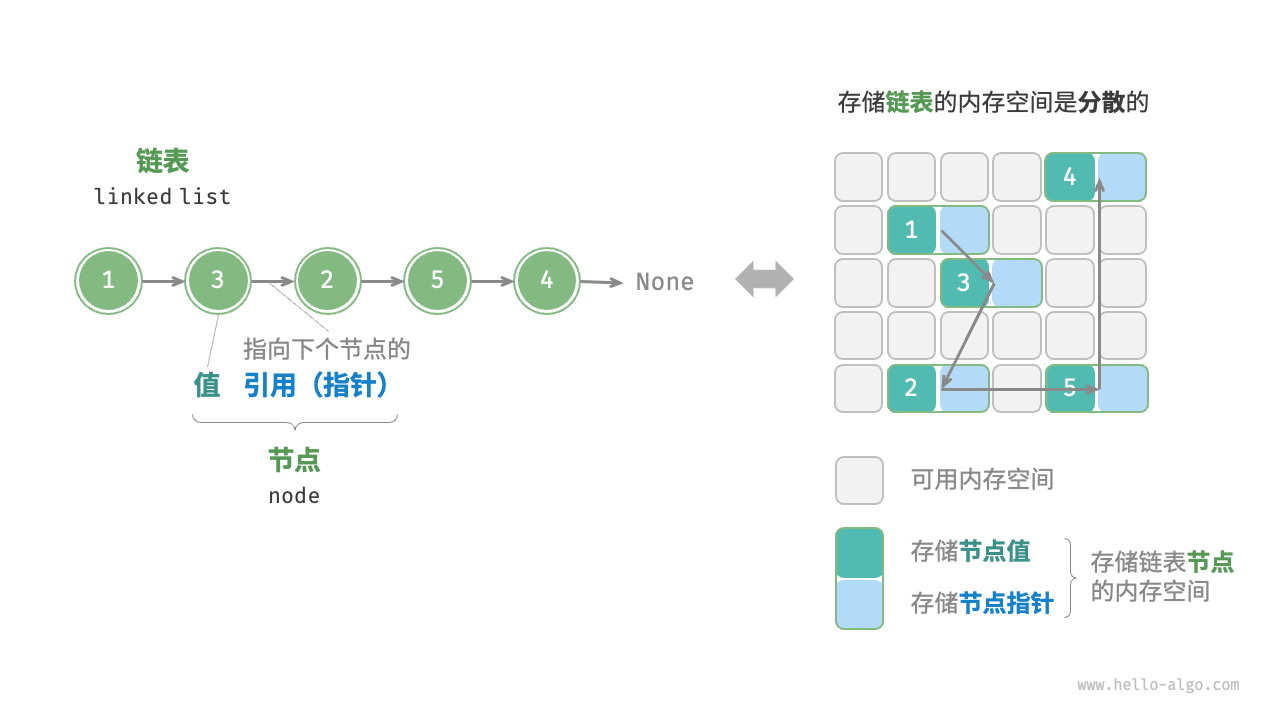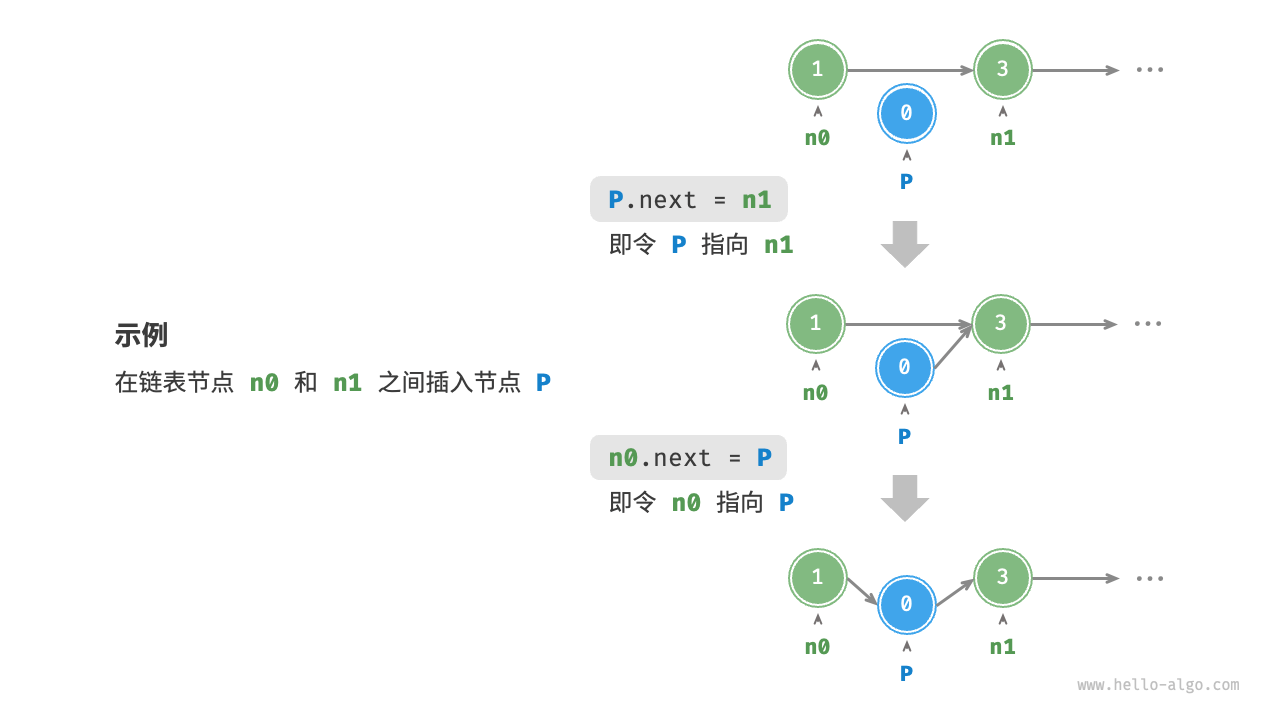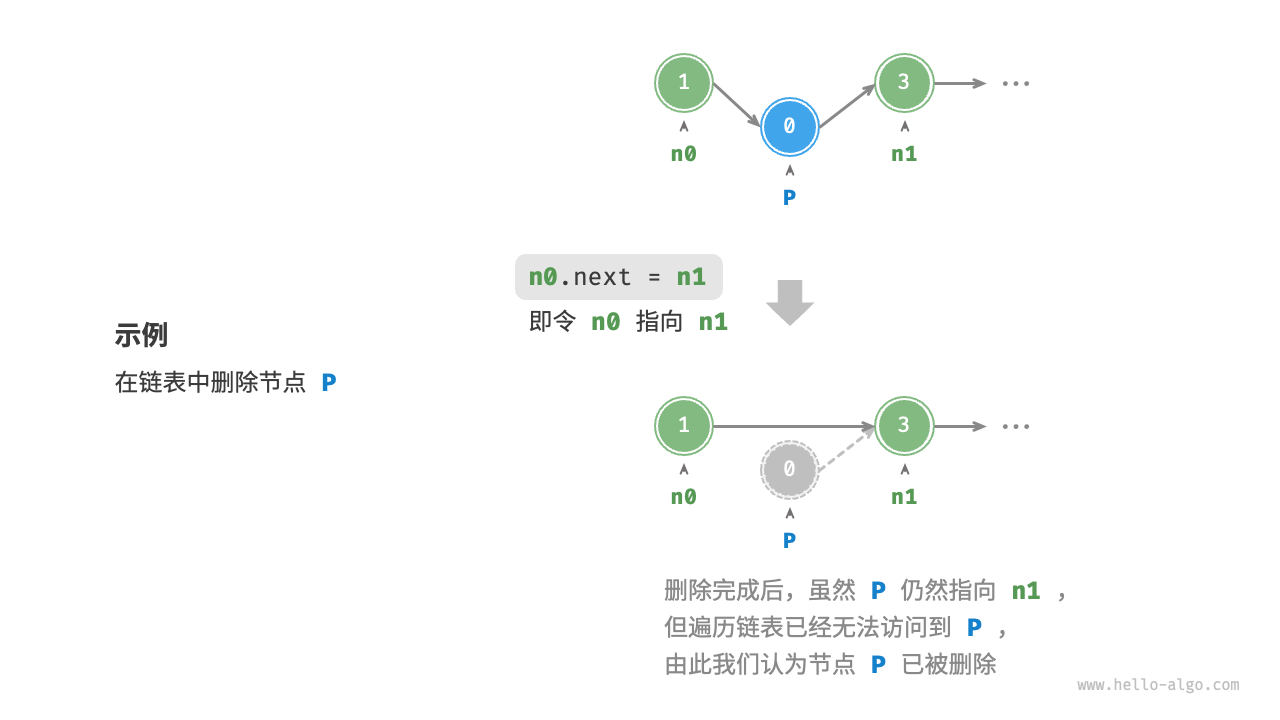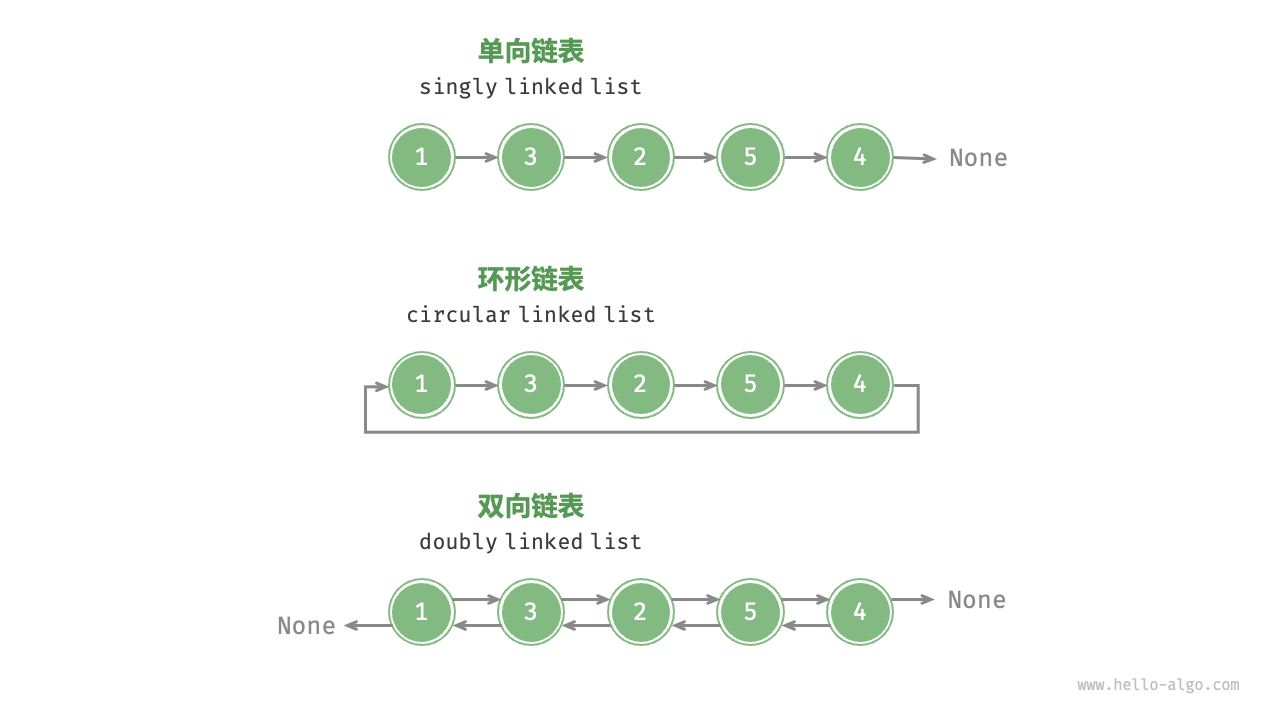4.2 链表
内存空间是所有程序的公共资源,在一个复杂的系统运行环境下,空闲的内存空间可能散落在内存各处。我们知道,存储数组的内存空间必须是连续的,而当数组非常大时,内存可能无法提供如此大的连续空间。此时链表的灵活性优势就体现出来了。
链表(linked list) 是一种线性数据结构,其中的每个元素都是一个节点对象,各个节点通过“引用”相连接。引用记录了下一个节点的内存地址,通过它可以从当前节点访问到下一个节点。
链表的设计使得各个节点可以分散存储在内存各处,它们的内存地址无须连续。
图 4-5 链表定义与存储方式
观察图 4-5 ,链表的组成单位是节点(node) 对象。每个节点都包含两项数据:节点的“值”和指向下一节点的“引用”。
链表的首个节点被称为“头节点”,最后一个节点被称为“尾节点”。
尾节点指向的是“空”,它在 Java、C++ 和 Python 中分别被记为 null、nullptr 和 None 。
在 C、C++、Go 和 Rust 等支持指针的语言中,上述“引用”应被替换为“指针”。
如以下代码所示,链表节点 ListNode 除了包含值,还需额外保存一个引用(指针)。因此在相同数据量下,链表比数组占用更多的内存空间 。
Python C++ Java C# Go Swift JS TS Dart Rust C Kotlin Ruby Zig
class ListNode :
"""链表节点类"""
def __init__ ( self , val : int ):
self . val : int = val # 节点值
self . next : ListNode | None = None # 指向下一节点的引用
/* 链表节点结构体 */
struct ListNode {
int val ; // 节点值
ListNode * next ; // 指向下一节点的指针
ListNode ( int x ) : val ( x ), next ( nullptr ) {} // 构造函数
};
/* 链表节点类 */
class ListNode {
int val ; // 节点值
ListNode next ; // 指向下一节点的引用
ListNode ( int x ) { val = x ; } // 构造函数
}
/* 链表节点类 */
class ListNode ( int x ) { //构造函数
int val = x ; // 节点值
ListNode ? next ; // 指向下一节点的引用
}
/* 链表节点结构体 */
type ListNode struct {
Val int // 节点值
Next * ListNode // 指向下一节点的指针
}
// NewListNode 构造函数,创建一个新的链表
func NewListNode ( val int ) * ListNode {
return & ListNode {
Val : val ,
Next : nil ,
}
}
/* 链表节点类 */
class ListNode {
var val : Int // 节点值
var next : ListNode ? // 指向下一节点的引用
init ( x : Int ) { // 构造函数
val = x
}
}
/* 链表节点类 */
class ListNode {
constructor ( val , next ) {
this . val = ( val === undefined ? 0 : val ); // 节点值
this . next = ( next === undefined ? null : next ); // 指向下一节点的引用
}
}
/* 链表节点类 */
class ListNode {
val : number ;
next : ListNode | null ;
constructor ( val? : number , next? : ListNode | null ) {
this . val = val === undefined ? 0 : val ; // 节点值
this . next = next === undefined ? null : next ; // 指向下一节点的引用
}
}
/* 链表节点类 */
class ListNode {
int val ; // 节点值
ListNode ? next ; // 指向下一节点的引用
ListNode ( this . val , [ this . next ]); // 构造函数
}
use std :: rc :: Rc ;
use std :: cell :: RefCell ;
/* 链表节点类 */
#[derive(Debug)]
struct ListNode {
val : i32 , // 节点值
next : Option < Rc < RefCell < ListNode >>> , // 指向下一节点的指针
}
/* 链表节点结构体 */
typedef struct ListNode {
int val ; // 节点值
struct ListNode * next ; // 指向下一节点的指针
} ListNode ;
/* 构造函数 */
ListNode * newListNode ( int val ) {
ListNode * node ;
node = ( ListNode * ) malloc ( sizeof ( ListNode ));
node -> val = val ;
node -> next = NULL ;
return node ;
}
/* 链表节点类 */
// 构造方法
class ListNode ( x : Int ) {
val _val : Int = x // 节点值
val next : ListNode? = null // 指向下一个节点的引用
}
# 链表节点类
class ListNode
attr_accessor :val # 节点值
attr_accessor :next # 指向下一节点的引用
def initialize ( val = 0 , next_node = nil )
@val = val
@next = next_node
end
end
// 链表节点类
pub fn ListNode ( comptime T : type ) type {
return struct {
const Self = @This ();
val : T = 0 , // 节点值
next : ?* Self = null , // 指向下一节点的指针
// 构造函数
pub fn init ( self : * Self , x : i32 ) void {
self . val = x ;
self . next = null ;
}
};
}
4.2.1 链表常用操作
1. 初始化链表
建立链表分为两步,第一步是初始化各个节点对象,第二步是构建节点之间的引用关系。初始化完成后,我们就可以从链表的头节点出发,通过引用指向 next 依次访问所有节点。
可视化运行
数组整体是一个变量,比如数组 nums 包含元素 nums[0] 和 nums[1] 等,而链表是由多个独立的节点对象组成的。我们通常将头节点当作链表的代称 ,比如以上代码中的链表可记作链表 n0 。
2. 插入节点
在链表中插入节点非常容易。如图 4-6 所示,假设我们想在相邻的两个节点 n0 和 n1 之间插入一个新节点 P ,则只需改变两个节点引用(指针)即可 ,时间复杂度为 \(O(1)\) 。
相比之下,在数组中插入元素的时间复杂度为 \(O(n)\) ,在大数据量下的效率较低。
图 4-6 链表插入节点示例
Python C++ Java C# Go Swift JS TS Dart Rust C Kotlin Ruby Zig
linked_list.py def insert ( n0 : ListNode , P : ListNode ):
"""在链表的节点 n0 之后插入节点 P"""
n1 = n0 . next
P . next = n1
n0 . next = P
linked_list.cpp /* 在链表的节点 n0 之后插入节点 P */
void insert ( ListNode * n0 , ListNode * P ) {
ListNode * n1 = n0 -> next ;
P -> next = n1 ;
n0 -> next = P ;
}
linked_list.java /* 在链表的节点 n0 之后插入节点 P */
void insert ( ListNode n0 , ListNode P ) {
ListNode n1 = n0 . next ;
P . next = n1 ;
n0 . next = P ;
}
linked_list.cs /* 在链表的节点 n0 之后插入节点 P */
void Insert ( ListNode n0 , ListNode P ) {
ListNode ? n1 = n0 . next ;
P . next = n1 ;
n0 . next = P ;
}
linked_list.go /* 在链表的节点 n0 之后插入节点 P */
func insertNode ( n0 * ListNode , P * ListNode ) {
n1 := n0 . Next
P . Next = n1
n0 . Next = P
}
linked_list.swift /* 在链表的节点 n0 之后插入节点 P */
func insert ( n0 : ListNode , P : ListNode ) {
let n1 = n0 . next
P . next = n1
n0 . next = P
}
linked_list.js /* 在链表的节点 n0 之后插入节点 P */
function insert ( n0 , P ) {
const n1 = n0 . next ;
P . next = n1 ;
n0 . next = P ;
}
linked_list.ts /* 在链表的节点 n0 之后插入节点 P */
function insert ( n0 : ListNode , P : ListNode ) : void {
const n1 = n0 . next ;
P . next = n1 ;
n0 . next = P ;
}
linked_list.dart /* 在链表的节点 n0 之后插入节点 P */
void insert ( ListNode n0 , ListNode P ) {
ListNode ? n1 = n0 . next ;
P . next = n1 ;
n0 . next = P ;
}
linked_list.rs /* 在链表的节点 n0 之后插入节点 P */
#[allow(non_snake_case)]
pub fn insert < T > ( n0 : & Rc < RefCell < ListNode < T >>> , P : Rc < RefCell < ListNode < T >>> ) {
let n1 = n0 . borrow_mut (). next . take ();
P . borrow_mut (). next = n1 ;
n0 . borrow_mut (). next = Some ( P );
}
linked_list.c /* 在链表的节点 n0 之后插入节点 P */
void insert ( ListNode * n0 , ListNode * P ) {
ListNode * n1 = n0 -> next ;
P -> next = n1 ;
n0 -> next = P ;
}
linked_list.kt /* 在链表的节点 n0 之后插入节点 P */
fun insert ( n0 : ListNode?, p : ListNode?) {
val n1 = n0 ?. next
p ?. next = n1
n0 ?. next = p
}
linked_list.rb ### 在链表的节点 n0 之后插入节点 _p ###
# Ruby 的 `p` 是一个内置函数, `P` 是一个常量,所以可以使用 `_p` 代替
def insert ( n0 , _p )
n1 = n0 . next
_p . next = n1
n0 . next = _p
end
linked_list.zig // 在链表的节点 n0 之后插入节点 P
fn insert ( n0 : ?* inc . ListNode ( i32 ), P : ?* inc . ListNode ( i32 )) void {
var n1 = n0 . ? . next ;
P . ? . next = n1 ;
n0 . ? . next = P ;
}
可视化运行
3. 删除节点
如图 4-7 所示,在链表中删除节点也非常方便,只需改变一个节点的引用(指针)即可 。
请注意,尽管在删除操作完成后节点 P 仍然指向 n1 ,但实际上遍历此链表已经无法访问到 P ,这意味着 P 已经不再属于该链表了。
图 4-7 链表删除节点
可视化运行
4. 访问节点
在链表中访问节点的效率较低 。如上一节所述,我们可以在 \(O(1)\) 时间下访问数组中的任意元素。链表则不然,程序需要从头节点出发,逐个向后遍历,直至找到目标节点。也就是说,访问链表的第 \(i\) 个节点需要循环 \(i - 1\) 轮,时间复杂度为 \(O(n)\) 。
Python C++ Java C# Go Swift JS TS Dart Rust C Kotlin Ruby Zig
linked_list.py def access ( head : ListNode , index : int ) -> ListNode | None :
"""访问链表中索引为 index 的节点"""
for _ in range ( index ):
if not head :
return None
head = head . next
return head
linked_list.cpp /* 访问链表中索引为 index 的节点 */
ListNode * access ( ListNode * head , int index ) {
for ( int i = 0 ; i < index ; i ++ ) {
if ( head == nullptr )
return nullptr ;
head = head -> next ;
}
return head ;
}
linked_list.java /* 访问链表中索引为 index 的节点 */
ListNode access ( ListNode head , int index ) {
for ( int i = 0 ; i < index ; i ++ ) {
if ( head == null )
return null ;
head = head . next ;
}
return head ;
}
linked_list.cs /* 访问链表中索引为 index 的节点 */
ListNode ? Access ( ListNode ? head , int index ) {
for ( int i = 0 ; i < index ; i ++ ) {
if ( head == null )
return null ;
head = head . next ;
}
return head ;
}
linked_list.go /* 访问链表中索引为 index 的节点 */
func access ( head * ListNode , index int ) * ListNode {
for i := 0 ; i < index ; i ++ {
if head == nil {
return nil
}
head = head . Next
}
return head
}
linked_list.swift /* 访问链表中索引为 index 的节点 */
func access ( head : ListNode , index : Int ) -> ListNode ? {
var head : ListNode ? = head
for _ in 0 .. < index {
if head == nil {
return nil
}
head = head ?. next
}
return head
}
linked_list.js /* 访问链表中索引为 index 的节点 */
function access ( head , index ) {
for ( let i = 0 ; i < index ; i ++ ) {
if ( ! head ) {
return null ;
}
head = head . next ;
}
return head ;
}
linked_list.ts /* 访问链表中索引为 index 的节点 */
function access ( head : ListNode | null , index : number ) : ListNode | null {
for ( let i = 0 ; i < index ; i ++ ) {
if ( ! head ) {
return null ;
}
head = head . next ;
}
return head ;
}
linked_list.dart /* 访问链表中索引为 index 的节点 */
ListNode ? access ( ListNode ? head , int index ) {
for ( var i = 0 ; i < index ; i ++ ) {
if ( head == null ) return null ;
head = head . next ;
}
return head ;
}
linked_list.rs /* 访问链表中索引为 index 的节点 */
pub fn access < T > ( head : Rc < RefCell < ListNode < T >>> , index : i32 ) -> Option < Rc < RefCell < ListNode < T >>>> {
fn dfs < T > (
head : Option <& Rc < RefCell < ListNode < T >>>> ,
index : i32 ,
) -> Option < Rc < RefCell < ListNode < T >>>> {
if index <= 0 {
return head . cloned ();
}
if let Some ( node ) = head {
dfs ( node . borrow (). next . as_ref (), index - 1 )
} else {
None
}
}
dfs ( Some ( head ). as_ref (), index )
}
linked_list.c /* 访问链表中索引为 index 的节点 */
ListNode * access ( ListNode * head , int index ) {
for ( int i = 0 ; i < index ; i ++ ) {
if ( head == NULL )
return NULL ;
head = head -> next ;
}
return head ;
}
linked_list.kt /* 访问链表中索引为 index 的节点 */
fun access ( head : ListNode?, index : Int ): ListNode? {
var h = head
for ( i in 0. . < index ) {
if ( h == null )
return null
h = h . next
}
return h
}
linked_list.rb ### 访问链表中索引为 index 的节点 ###
def access ( head , index )
for i in 0 ... index
return nil if head . nil?
head = head . next
end
head
end
linked_list.zig // 访问链表中索引为 index 的节点
fn access ( node : ?* inc . ListNode ( i32 ), index : i32 ) ?* inc . ListNode ( i32 ) {
var head = node ;
var i : i32 = 0 ;
while ( i < index ) : ( i += 1 ) {
head = head . ? . next ;
if ( head == null ) return null ;
}
return head ;
}
可视化运行
5. 查找节点
遍历链表,查找其中值为 target 的节点,输出该节点在链表中的索引。此过程也属于线性查找。代码如下所示:
Python C++ Java C# Go Swift JS TS Dart Rust C Kotlin Ruby Zig
linked_list.py def find ( head : ListNode , target : int ) -> int :
"""在链表中查找值为 target 的首个节点"""
index = 0
while head :
if head . val == target :
return index
head = head . next
index += 1
return - 1
linked_list.cpp /* 在链表中查找值为 target 的首个节点 */
int find ( ListNode * head , int target ) {
int index = 0 ;
while ( head != nullptr ) {
if ( head -> val == target )
return index ;
head = head -> next ;
index ++ ;
}
return -1 ;
}
linked_list.java /* 在链表中查找值为 target 的首个节点 */
int find ( ListNode head , int target ) {
int index = 0 ;
while ( head != null ) {
if ( head . val == target )
return index ;
head = head . next ;
index ++ ;
}
return - 1 ;
}
linked_list.cs /* 在链表中查找值为 target 的首个节点 */
int Find ( ListNode ? head , int target ) {
int index = 0 ;
while ( head != null ) {
if ( head . val == target )
return index ;
head = head . next ;
index ++ ;
}
return - 1 ;
}
linked_list.go /* 在链表中查找值为 target 的首个节点 */
func findNode ( head * ListNode , target int ) int {
index := 0
for head != nil {
if head . Val == target {
return index
}
head = head . Next
index ++
}
return - 1
}
linked_list.swift /* 在链表中查找值为 target 的首个节点 */
func find ( head : ListNode , target : Int ) -> Int {
var head : ListNode ? = head
var index = 0
while head != nil {
if head ?. val == target {
return index
}
head = head ?. next
index += 1
}
return - 1
}
linked_list.js /* 在链表中查找值为 target 的首个节点 */
function find ( head , target ) {
let index = 0 ;
while ( head !== null ) {
if ( head . val === target ) {
return index ;
}
head = head . next ;
index += 1 ;
}
return - 1 ;
}
linked_list.ts /* 在链表中查找值为 target 的首个节点 */
function find ( head : ListNode | null , target : number ) : number {
let index = 0 ;
while ( head !== null ) {
if ( head . val === target ) {
return index ;
}
head = head . next ;
index += 1 ;
}
return - 1 ;
}
linked_list.dart /* 在链表中查找值为 target 的首个节点 */
int find ( ListNode ? head , int target ) {
int index = 0 ;
while ( head != null ) {
if ( head . val == target ) {
return index ;
}
head = head . next ;
index ++ ;
}
return - 1 ;
}
linked_list.rs /* 在链表中查找值为 target 的首个节点 */
pub fn find < T : PartialEq > ( head : Rc < RefCell < ListNode < T >>> , target : T ) -> i32 {
fn find < T : PartialEq > ( head : Option <& Rc < RefCell < ListNode < T >>>> , target : T , idx : i32 ) -> i32 {
if let Some ( node ) = head {
if node . borrow (). val == target {
return idx ;
}
return find ( node . borrow (). next . as_ref (), target , idx + 1 );
} else {
- 1
}
}
find ( Some ( head ). as_ref (), target , 0 )
}
linked_list.c /* 在链表中查找值为 target 的首个节点 */
int find ( ListNode * head , int target ) {
int index = 0 ;
while ( head ) {
if ( head -> val == target )
return index ;
head = head -> next ;
index ++ ;
}
return -1 ;
}
linked_list.kt /* 在链表中查找值为 target 的首个节点 */
fun find ( head : ListNode?, target : Int ): Int {
var index = 0
var h = head
while ( h != null ) {
if ( h . _val == target )
return index
h = h . next
index ++
}
return - 1
}
linked_list.rb ### 在链表中查找值为 target 的首个节点 ###
def find ( head , target )
index = 0
while head
return index if head . val == target
head = head . next
index += 1
end
- 1
end
linked_list.zig // 在链表中查找值为 target 的首个节点
fn find ( node : ?* inc . ListNode ( i32 ), target : i32 ) i32 {
var head = node ;
var index : i32 = 0 ;
while ( head != null ) {
if ( head . ? . val == target ) return index ;
head = head . ? . next ;
index += 1 ;
}
return - 1 ;
}
可视化运行
4.2.2 数组 vs. 链表
表 4-1 总结了数组和链表的各项特点并对比了操作效率。由于它们采用两种相反的存储策略,因此各种性质和操作效率也呈现对立的特点。
表 4-1 数组与链表的效率对比
数组
链表
存储方式
连续内存空间
分散内存空间
容量扩展
长度不可变
可灵活扩展
内存效率
元素占用内存少、但可能浪费空间
元素占用内存多
访问元素
\(O(1)\) \(O(n)\)
添加元素
\(O(n)\) \(O(1)\)
删除元素
\(O(n)\) \(O(1)\)
4.2.3 常见链表类型
如图 4-8 所示,常见的链表类型包括三种。
单向链表 :即前面介绍的普通链表。单向链表的节点包含值和指向下一节点的引用两项数据。我们将首个节点称为头节点,将最后一个节点称为尾节点,尾节点指向空 None 。环形链表 :如果我们令单向链表的尾节点指向头节点(首尾相接),则得到一个环形链表。在环形链表中,任意节点都可以视作头节点。双向链表 :与单向链表相比,双向链表记录了两个方向的引用。双向链表的节点定义同时包含指向后继节点(下一个节点)和前驱节点(上一个节点)的引用(指针)。相较于单向链表,双向链表更具灵活性,可以朝两个方向遍历链表,但相应地也需要占用更多的内存空间。
Python C++ Java C# Go Swift JS TS Dart Rust C Kotlin Ruby Zig
class ListNode :
"""双向链表节点类"""
def __init__ ( self , val : int ):
self . val : int = val # 节点值
self . next : ListNode | None = None # 指向后继节点的引用
self . prev : ListNode | None = None # 指向前驱节点的引用
/* 双向链表节点结构体 */
struct ListNode {
int val ; // 节点值
ListNode * next ; // 指向后继节点的指针
ListNode * prev ; // 指向前驱节点的指针
ListNode ( int x ) : val ( x ), next ( nullptr ), prev ( nullptr ) {} // 构造函数
};
/* 双向链表节点类 */
class ListNode {
int val ; // 节点值
ListNode next ; // 指向后继节点的引用
ListNode prev ; // 指向前驱节点的引用
ListNode ( int x ) { val = x ; } // 构造函数
}
/* 双向链表节点类 */
class ListNode ( int x ) { // 构造函数
int val = x ; // 节点值
ListNode next ; // 指向后继节点的引用
ListNode prev ; // 指向前驱节点的引用
}
/* 双向链表节点结构体 */
type DoublyListNode struct {
Val int // 节点值
Next * DoublyListNode // 指向后继节点的指针
Prev * DoublyListNode // 指向前驱节点的指针
}
// NewDoublyListNode 初始化
func NewDoublyListNode ( val int ) * DoublyListNode {
return & DoublyListNode {
Val : val ,
Next : nil ,
Prev : nil ,
}
}
/* 双向链表节点类 */
class ListNode {
var val : Int // 节点值
var next : ListNode ? // 指向后继节点的引用
var prev : ListNode ? // 指向前驱节点的引用
init ( x : Int ) { // 构造函数
val = x
}
}
/* 双向链表节点类 */
class ListNode {
constructor ( val , next , prev ) {
this . val = val === undefined ? 0 : val ; // 节点值
this . next = next === undefined ? null : next ; // 指向后继节点的引用
this . prev = prev === undefined ? null : prev ; // 指向前驱节点的引用
}
}
/* 双向链表节点类 */
class ListNode {
val : number ;
next : ListNode | null ;
prev : ListNode | null ;
constructor ( val? : number , next? : ListNode | null , prev? : ListNode | null ) {
this . val = val === undefined ? 0 : val ; // 节点值
this . next = next === undefined ? null : next ; // 指向后继节点的引用
this . prev = prev === undefined ? null : prev ; // 指向前驱节点的引用
}
}
/* 双向链表节点类 */
class ListNode {
int val ; // 节点值
ListNode ? next ; // 指向后继节点的引用
ListNode ? prev ; // 指向前驱节点的引用
ListNode ( this . val , [ this . next , this . prev ]); // 构造函数
}
use std :: rc :: Rc ;
use std :: cell :: RefCell ;
/* 双向链表节点类型 */
#[derive(Debug)]
struct ListNode {
val : i32 , // 节点值
next : Option < Rc < RefCell < ListNode >>> , // 指向后继节点的指针
prev : Option < Rc < RefCell < ListNode >>> , // 指向前驱节点的指针
}
/* 构造函数 */
impl ListNode {
fn new ( val : i32 ) -> Self {
ListNode {
val ,
next : None ,
prev : None ,
}
}
}
/* 双向链表节点结构体 */
typedef struct ListNode {
int val ; // 节点值
struct ListNode * next ; // 指向后继节点的指针
struct ListNode * prev ; // 指向前驱节点的指针
} ListNode ;
/* 构造函数 */
ListNode * newListNode ( int val ) {
ListNode * node ;
node = ( ListNode * ) malloc ( sizeof ( ListNode ));
node -> val = val ;
node -> next = NULL ;
node -> prev = NULL ;
return node ;
}
/* 双向链表节点类 */
// 构造方法
class ListNode ( x : Int ) {
val _val : Int = x // 节点值
val next : ListNode? = null // 指向后继节点的引用
val prev : ListNode? = null // 指向前驱节点的引用
}
# 双向链表节点类
class ListNode
attr_accessor :val # 节点值
attr_accessor :next # 指向后继节点的引用
attr_accessor :prev # 指向前驱节点的引用
def initialize ( val = 0 , next_node = nil , prev_node = nil )
@val = val
@next = next_node
@prev = prev_node
end
end
// 双向链表节点类
pub fn ListNode ( comptime T : type ) type {
return struct {
const Self = @This ();
val : T = 0 , // 节点值
next : ?* Self = null , // 指向后继节点的指针
prev : ?* Self = null , // 指向前驱节点的指针
// 构造函数
pub fn init ( self : * Self , x : i32 ) void {
self . val = x ;
self . next = null ;
self . prev = null ;
}
};
}
图 4-8 常见链表种类
4.2.4 链表典型应用
单向链表通常用于实现栈、队列、哈希表和图等数据结构。
栈与队列 :当插入和删除操作都在链表的一端进行时,它表现的特性为先进后出,对应栈;当插入操作在链表的一端进行,删除操作在链表的另一端进行,它表现的特性为先进先出,对应队列。哈希表 :链式地址是解决哈希冲突的主流方案之一,在该方案中,所有冲突的元素都会被放到一个链表中。图 :邻接表是表示图的一种常用方式,其中图的每个顶点都与一个链表相关联,链表中的每个元素都代表与该顶点相连的其他顶点。
双向链表常用于需要快速查找前一个和后一个元素的场景。
高级数据结构 :比如在红黑树、B 树中,我们需要访问节点的父节点,这可以通过在节点中保存一个指向父节点的引用来实现,类似于双向链表。浏览器历史 :在网页浏览器中,当用户点击前进或后退按钮时,浏览器需要知道用户访问过的前一个和后一个网页。双向链表的特性使得这种操作变得简单。LRU 算法 :在缓存淘汰(LRU)算法中,我们需要快速找到最近最少使用的数据,以及支持快速添加和删除节点。这时候使用双向链表就非常合适。
环形链表常用于需要周期性操作的场景,比如操作系统的资源调度。
时间片轮转调度算法 :在操作系统中,时间片轮转调度算法是一种常见的 CPU 调度算法,它需要对一组进程进行循环。每个进程被赋予一个时间片,当时间片用完时,CPU 将切换到下一个进程。这种循环操作可以通过环形链表来实现。数据缓冲区 :在某些数据缓冲区的实现中,也可能会使用环形链表。比如在音频、视频播放器中,数据流可能会被分成多个缓冲块并放入一个环形链表,以便实现无缝播放。



